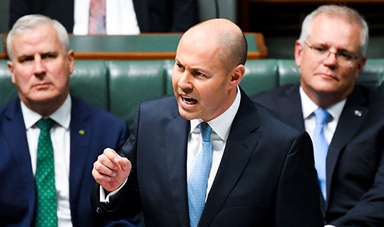Loading component...
At a glance
A budget cornerstone is an additional A$15 billion in infrastructure commitments, complemented by economic measures such as a boost to training, support for the aviation and tourism sectors and an extension of measures to drive home ownership.
There is also the extension of support to taxpayers through the retention of the low and middle-income tax offset for 2021-22, which will deliver up to A$1080 for lower and middle-income earners.
The Treasurer’s message was that while Australia has come through the COVID-19 disruptions well, now is not the time for budget repair.
Rather, the government has opted to run a budget deficit of A$161 billion this year, falling to A$57 billion in 2024-5 as the economy recovers and tax receipts increase.
The budget, said Frydenberg, would help create more than 250,000 jobs by the end of the 2022-23 financial year.
Net debt will increase to A$617.5 billion or 30 percent of GDP this year and peak at A$980.6 billion or 40.9 percent of GDP in June 2025.
Frydenberg’s point is that Australia can increase its debt now because the government’s net debt is low by comparison to many similar advanced economies and the cost of that debt remains low.
“As a share of the economy, net debt is around half of that in the UK and US, and less than a third of that in Japan,” he said.
“We are better placed than nearly any other country to meet the economic challenges that lie ahead.”
CPA Australia has described the budget as “expansionary” and with more hits than misses.
CPA Australia’s General Manager External Affairs, Dr Jane Rennie comments, “After years of focusing on achieving budget surpluses, the government has recognised the importance of continuing to use fiscal policy levers. This is a sensible approach given ongoing COVID uncertainty and low wages growth.”
While lauding the focus on “historically underfunded” areas of health, aged care and women’s economic security, Dr Rennie says there is a “disconnect” between the government’s digital ambitions and its implementation.
“The government’s aspirations for a digital economy are positive, but it has underestimated the size of the digital challenge confronting Australia’s small businesses and their capacity to overcome it.”
Frydenberg forecast economic growth of 1.25 per cent in 2020-21, rising to 4.25 per cent in 2021-22.
The 2021 budget is in the same vein as last year, when instead of bringing the budget back “into the black” as it had celebrated before the pandemic, the government forecast a deficit of A$213.7 billion in 2020-21. However, that deficit has proven to be overly pessimistic, with the government now forecasting a deficit for that fiscal year of A$161.0 billion. This is thanks to lower-than-expected outgoings due in part to lower than forecast unemployment and increased tax receipts, partly driven by record iron ore prices.
See all of CPA Australia’s budget coverage.
Winners
Australian Women

Last year’s budget was highly criticised for doing very little for women, with then employment minister Michaela Cash belatedly pointing to funding for roads that women would also use.
This year, perhaps given recent controversies, the spending on programs for women is more high profile, with a A$354 million allocation for women’s health.
This includes improved cervical and breast cancer screening, depression services for pregnant women and programs for eating disorders.
There is also $A998 million over four years to combat domestic violence.
The measures also extend to superannuation, with employees who earn less than A$450 a month – the majority of whom are women – now being paid the superannuation guarantee.
First home buyers and single parents

The government has followed up last year’s Homebuilder scheme and extended support to first home buyers, helping another 10,000 first home buyers to build a new home with a 5 per cent deposit.
In addition, the budget will support 10,000 single parents to purchase homes with a deposit of 2 per cent. This measure is also primarily aimed at assisting women, who make up most single parents.
Once again, however, the government’s housing measures will be unpopular with the superannuation industry, as the budget increases the amount that can be released under the First Home Super Saver Scheme from $30,000 to $50,000.
CPA Australia describes this measure as tokenistic and unlikely to have a large take up. Dr Rennie states: “The existing scheme is poorly subscribed, and this token increase is unlikely to help more Australians purchase their first home.”
Low and middle-income families needing childcare

As had been leaked extensively in the days leading up to the budget, the government is providing $A1.7 billion to the childcare sector.
The Treasurer estimated that 250,000 families would be better off by an average of $A2,200 each year, “giving more parents, especially women, the choice to take on extra work.”
There are catches, however; the measures apply only to families with more than one child and the benefits won’t start flowing until 1 July 2022.
Dr Rennie says, “Affordable childcare is a significant barrier to women’s workforce participation and this investment will have a direct impact. However, it’s disappointing that families are being asked to wait another year to access these savings and we urge the government to bring forward the commencement date.”
Road and transport service users all around Australia

The budget includes a A$15 billion in commitments for national road and transport projects, with every state receiving Federal Funding.
There is funding for the North-South Corridor in South Australia, highway upgrades in the Northern Territory, Tasmania and Queensland, while Western Australia and the Australian Capital Territory receive funding for rail and light rail projects.
In NSW, , and upgrades for Newcastle Airport, while the investment in Victoria is in transport logistics, in the new Melbourne Intermodal Terminal.
In addition, a further A$1 billion in local road infrastructure projects and A$1 billion for road safety programs.
Trainees and apprentices
The budget doubles the government commitment to the JobTrainer Fund, supporting more than 450,000 new training places to upskill job seekers and young people.
At a cost of A$2.7 billion, the budget aims to create more than 170,000 new apprenticeships and traineeships, and also seeks to “help more women break into non-traditional roles” with training support for 5,000 places.
“We will provide 2,700 places in Indigenous girls academies to help them finish school and enter the workforce,” the Treasurer says.
“And more STEM scholarships for women, in partnership with industry. Tonight we are providing another 5,000 places in higher education short courses.”
Aged care, the NDIS and mental health services

In response to the Royal Commission into Aged Care Quality and Safety, the budget commits A$17.7 billion in “practical and targeted new funding to significantly improve the system.”
“We will fund another 80,000 home care packages, bringing the total to 275,000 home care packages available,” the Treasurer said.
“We will make an additional payment of A$10 per resident per day to enhance the viability and sustainability of the residential aged care sector.”
There is also support for 33,000 new training places for personal carers.
For the National Disability Insurance Scheme, the budget allocates a further A$13.2 billion over four years, with the Treasurer making a commitment that under the Coalition, the “NDIS will always be fully funded.”
There is also a commitment to mental health services, with a A$2.3 billion allocation to mental health care and suicide prevention.
This includes the establishment of more Headspace centres to support more young Australians, and expanding this model to care for those over 25, with the creation of a national network of 40 new Head to Health centres.
Startup and small and medium-sized businesses
The budget includes a number of measures to help small business, beginning with a one-year extension to the full expensing and temporary loss carry back tax provisions.
This is estimated to deliver a further A$20.7 billion in tax relief to businesses over the forward estimates.
Startup businesses will be heartened by the introduction of a “patent box”, similar to those in place in the UK and France.
From July 2022 the patent box will tax income derived from medical and biotech patents at a concessional 17 per cent tax rate, against the normal corporate tax of 30 per cent or 25 per cent for SME’s.
For startups, the budget defers tax for employee share schemes, making it easier to offer equity incentives to start up employees and give them “a share in the economic value they create through their hard work and ingenuity.”
CPA Australia reacted positively to these announcements, with Dr Rennie stating: “These changes go some way to enhancing Australia’s attractiveness as a place to work and invest.”
She does also warn, however, that the true test of the effectiveness of these reforms “will be how they stack up against other jurisdictions.”
Brewers and distillers

It might seem the government has deviated from its usual script, but the budget includes tax relief for brewers and distillers “to support jobs and further grow Australia’s alcohol manufacturing sector.”
In recognition of the rise of the craft beer and boutique spirits industry, from 2021, all eligible brewers and distillers will receive full remission of any excise they pay on the alcohol they produce up to a cap of A$350,000 each financial year.
This is an increase from the previous 60 percent rebate, and the cap of A$100,000.
The government calculates that around 600 brewers and distillers will benefit from A$225 million in tax relief over the forward estimates period.
Losers
Universities
The budget estimates that the international borders won’t open until 2022, depending on the pace of vaccinations, and even if this occurs it will be some time before international students return to Australia.
The budget does not earmark any specific funding for the university sector.
Renewable energy
Although the Treasurer says Australia is moving to net zero emissions “preferably” by 2050, much of the energy expenditure is going into low emissions technologies, not renewable energy.
There is A$275 million for four new hydrogen production hubs and a A$237 million allocation for carbon capture and storage, a technology which climate activists say is still unproven.
The biggest direct funding allocation for renewable energy is A$30 million for a microgrid and battery project in the Northern Territory.
Reacting to these announcements, Dr Rennie adds, “Carbon capture and storage technologies won’t get Australia to net zero, the same way owning a carbon fibre bike doesn’t make you a cyclist.”
Migrants
Migrants who are granted residency from January 1, 2022, will have to wait for four years until they can access Government benefits.
This measure, which is expected to impact 13,200 future migrants, is estimated to save A$45.7 million in 2022-23 and increase to A$415.2 million in 2024-25.
Small businesses looking to digitise
Of the government’s A$1.2 billion Digital Economy Strategy, only A$28 million is directly allocated to help small businesses digitise and A$6.9 billion is allocated to assist small businesses upgrade their cybersecruity.
In reacting to this, Dr Rennie states, “Investing in regtech without helping businesses digitalise, is a bit like trying to turn half a light bulb on and keep the other half off. It won’t work, it’s short-sighted and really quite disappointing.”

